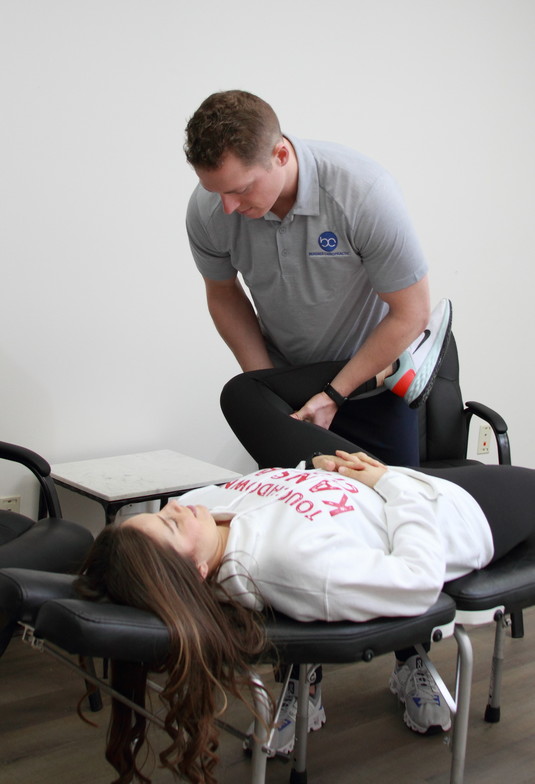
You Deserve More from Your Chiropractor
Chiropractic care has developed a less-than-stellar reputation over the years. Many patients express frustration with the repetitive nature of their visits—often feeling like they're stuck in an endless cycle with no clear end in sight. Why does it feel this way? Because, in many cases, it is. The typical visit involves a brief encounter: you walk in, lay down, get adjusted quickly, hit the roller table, and then you’re on your way.
Is this truly patient-centered care?
When a chiropractor spends 5 minutes or less with a patient, how much clinical reasoning can realistically go into the decisions they make? How do they determine where to adjust? What is the outcome? Was there an improvement in range of motion afterward? Was motor control enhanced? How are they even assessing these aspects?
It's hard to believe that meaningful decisions can be made within such a short time frame. Moreover, I don't know a single patient who thinks a 5-minute visit offers great value. Yet, many patients find themselves caught up in this model.
The chiropractic profession needs a paradigm shift. I’ll explore what this shift should look like, but first, let's discuss how we got here.
Why the Short Visit Model is So Predominant Today
Many chiropractors would argue that they don’t need more than 5 minutes with a patient because they've already reviewed the X-rays and know what needs to be done. However, with such limited time, how can they truly track or confirm progress? If X-rays are guiding each visit, is your chiropractor taking the time to review them with you each time? And let’s be clear: X-rays show bones, but chiropractors can’t move bones. We can influence the joints between the bones, but claiming to correct bone alignment is a significant overstatement.
Another common rationale is that they’re simply removing nervous system interference—a quick adjustment supposedly accomplishes this, so why do more? The problem is there’s zero evidence to support this claim. Not one shred of research backs it up—and trust me, I’ve looked because I wanted it to be true. It’s almost impossible to measure, except in cases with clear, objective neurological symptoms like neuropathies, multiple sclerosis (MS), sciatica, carpal tunnel syndrome, Parkinson’s disease, etc. Nervous system "interference" manifests as specific symptoms like burning, numbness, muscle weakness, or motor control difficulties. To claim someone has nervous system interference without these symptoms is more of a marketing tactic than a clinical reality—whether it's intentional or not.
This leads us to the main reason I believe chiropractic has reached this point:
Short visits are good for business.
Insurance companies pay chiropractors low rates—on average, about $38 per visit. If you see a patient for 5 minutes, you can see 10+ patients per hour, making $380 an hour. That’s a good return on your time. On the flip side, it's hard to justify charging much more than $50 per visit when you’re only seeing a patient for 5 minutes and doing the same thing every time. So, the solution is simple: sell the short visit as something life-changing. "We’re removing nervous system interference," or "The X-rays show issues with your back, let’s fix that." Unfortunately, the insurance model has led to clinical decisions being influenced more by profit than by what's best for the patient.
What You Deserve from Your Chiropractor
Here’s where that paradigm shift comes in. Chiropractors do distinguish themselves by the adjustment—it’s their hallmark. This identity makes them hesitant to adopt a more robust, holistic model because they fear it would betray traditional chiropractic principles. But here’s the crux: we know that a more holistic approach—including soft-tissue work, rehab, and lifestyle changes—yields better, long-term outcomes for patients. So why wouldn’t we make the shift?
There are countless opportunities for chiropractors today to excel in these aspects of patient care. Numerous seminars and certifications are available, and the digital age has opened up vast opportunities for continuous learning. We owe it to our patients to offer a truly holistic product, not just one labeled as such.
As a patient, here’s what you deserve from your chiropractor in today’s world:
In-Person Sessions
This is the traditional model—you receive care when you’re there in person. It’s crucial because the connection, the ability to touch, feel, and observe in real-time, is incredibly important. But as highlighted earlier, a 5-minute session is not enough. Even at three times per week, that's only 15 minutes of care. You spend 99% of your life outside their office, so we need to maximize these in-person sessions. Here’s what to look for in a provider:
- Thorough, Movement-Based Assessment and Consultation: X-rays alone are not a thorough assessment. Most adults over 30 have abnormal X-ray findings, often without symptoms. While X-rays are sometimes necessary, they shouldn’t be the primary assessment tool. A thorough assessment should be movement-based, checking for range of motion, strength, and asymmetries, joint by joint. Functional tests like squats, toe touches, and lunges—tests that get your body moving—should be utilized. Why? Because how your body moves is the ultimate piece of data needed to create a long-term plan.
- A Multidisciplinary Approach: Many providers rely solely on adjustments. As the saying goes, “When all you have is a hammer, everything looks like a nail.” If adjustments are the only tool your chiropractor uses, then the initial consultation doesn’t matter much (aside from recognizing major red flags). What’s the solution to every problem? An adjustment. Foot pain? Adjust the foot. Shoulder pain? Adjust the shoulder. For all pain? Adjust the spine. It’s a cookie-cutter approach disguised as unique and individualized care. Your chiropractor should have multiple tools and be able to explain how each works and why they’re using it.
Digital Support
We live in a digital age, so you should have digital support from your chiropractor. Are they providing you with an exercise portal? Can they track your progress? Are you able to communicate with them easily? How about lifestyle habits—are they helping you track those too? These are essential components of a truly holistic solution, and they’re accessible to all providers today. Your chiropractor should incorporate these into your care so you’re supported even when you’re not in the office.
Objective Goals
This is a significant piece often missing in care plans. Many patients see their chiropractors for years with no end in sight because they’ve lost sight of the goal. Your chiropractor should have objective measures like improvements in range of motion, motor control, and movement assessments. If the only objective goal is pain reduction, you may find yourself seeing your chiropractor weekly for years on end.
Conclusion
I hope this doesn’t come off as entirely negative. My frustration stems from the belief that we, as a profession, can do better for our patients. At Bergner Chiropractic, we’ve modeled our practice to reflect these principles. We offer longer, in-person sessions that incorporate adjustments, soft-tissue work, and rehab. We provide virtual support tools with clear, easy-to-follow exercise plans and track your habits and lifestyle choices. We conduct weekly check-ins to discuss progress, address frustrations, and celebrate wins.
Chiropractic care has long been touted as holistic. However, when scrutinized, it often reveals a myopic approach relying exclusively on one tool—the adjustment. I believe you, as a patient, deserve more.
If you’re ready to find a provider that can offer you more, don’t hesitate to book a free call with us using the link below. We’ll have an honest conversation to see if/how we can help.
Dr. Luke Bergner
Contact Me

